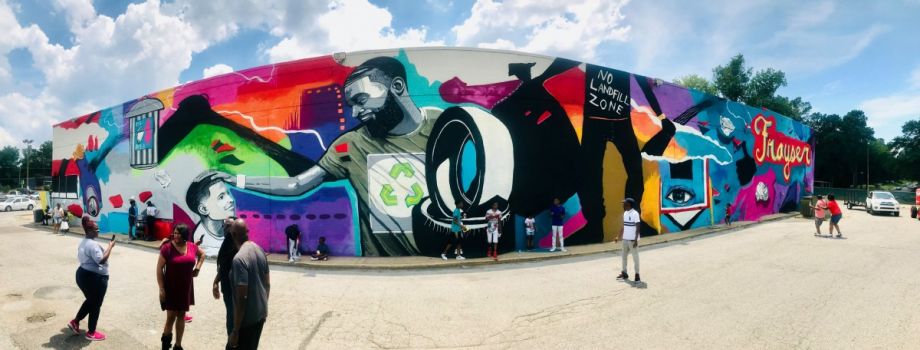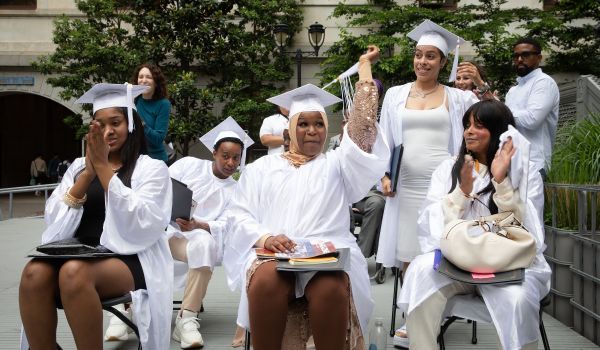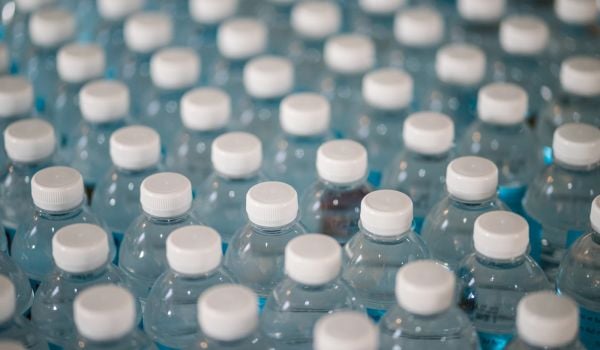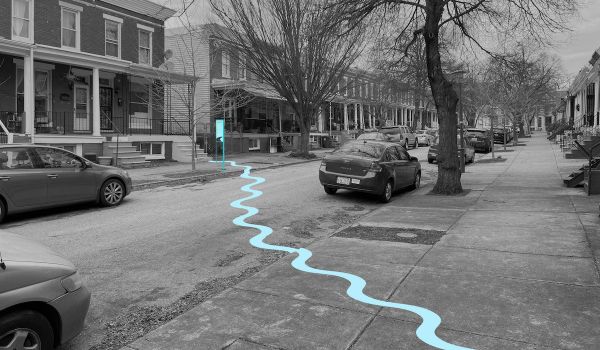Reaching high above North Main Street in Memphis, stylized depictions of colorful water droplets cover 6,000 square feet of the side of the Memphis Area Transit Authority’s trolley facility.
Created by graphic artist Khara Woods and titled “Basin Portraits,” it’s a bright spot along an otherwise unremarkable street, giving those walking or driving by something beautiful to look at on the way to where they’re going. But it’s also a complex interpretation of an environmental issue specific to the neighborhood that surrounds the mural: litter.
When you step closer to the mural, you see that the water droplets are pictographs: each has a specific symbol inside, which can be deciphered through a key that’s at the bottom.
Each water droplet represents a type of litter, with the color showing what material the litter was made out of — plastic, styrofoam, glass — and the interior symbol depicting whether the litter was a wrapper, a broken item, a cup, etc.
“Basin Portraits,” as well as another mural titled “Stand Up for Our Streets” by the artist Jamond Bullock, were commissioned by The UrbanArt Commission (UAC) in Memphis, a nonprofit public art and urban design organization, that was accepted into a capacity-building program based in Philadelphia to develop sustainable, participatory and collaborative models for public art in their communities.
“What was really interesting was that neither of the [two artists] really made work about the environment in their own practice before this project,” says Lauren Kennedy, executive director of UAC. “So how to think about that in the context of this initiative, and the specific environmental issues for these neighborhoods was new.”
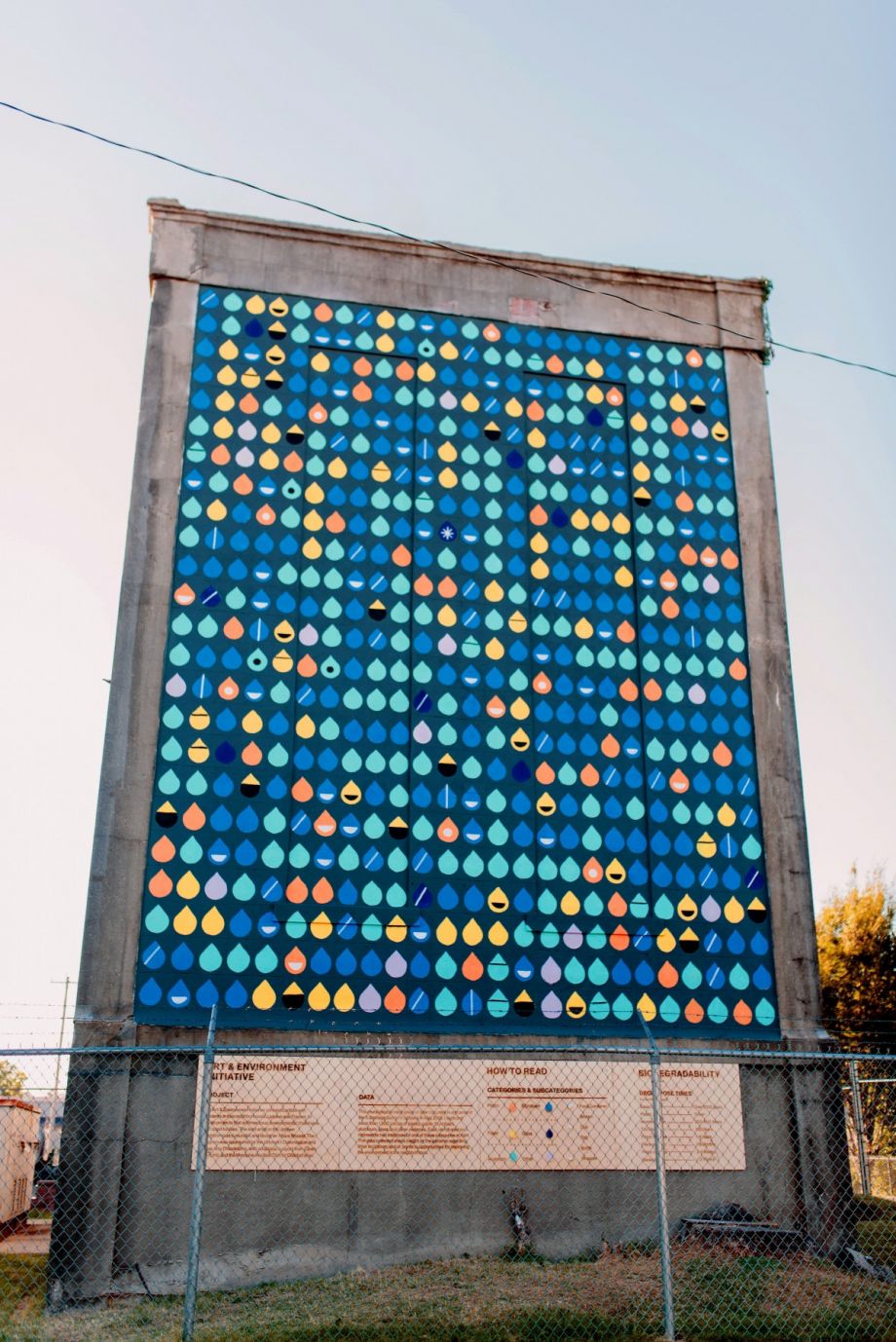
“Basin Portraits” by Khara Woods (photo by Shira Wilson, courtesy Mural Arts Philadelphia)
The founder and organizer of the Art & Environment initiative, Mural Arts Philadelphia, is one of the most prestigious nonprofits working in the field of public, participatory art. The Memphis team, along with teams from Detroit and Akron, Oh., were the first participants in this two-year program, selected in 2018.
Recently, Mural Arts announced its second cohort: Three groups from Santa Fe, New Mexico, Austin, Texas, and Kern County, California will embark on public art projects that address local environmental issues over the next two years.
Mural Arts Philadelphia will provide them with capacity building support throughout the project’s duration.
Each team, made up of artists, scholars, activists, and environmental experts, works over a two-year period to create public art around the theme of climate change and climate resilience, and that are reflective of the issues their communities are facing.
While those issues vary to a degree from city to city, they share a common basis in environmental racism, the loss of cultural identity, and environmental justice. The current cohort will present their completed projects in 2022.
“Environmental justice is such an intersectional force,” says Netanel Portier, director of the Mural Arts Institute. “And it’s so urgent right now.”
It’s due precisely to this intersectionality that Mural Arts, which also has programs dedicated to public art in service of social justice, restorative justice, education, and other issues, created the Art & Environment initiative.
Of course, for Mural Arts, “the environment” is not just the natural environment. It’s also the built environment — where people live, work, play, and pray. And one of the organization’s core beliefs is that people have the fundamental right to determine what those spaces look like.
“We saw the promise of bringing together environmental justice partners with art partners, bringing them together in new and creative ways, through this participatory art-making process,” Portier says.
In Memphis, that promise took the form of not just the two murals, but the way that each artist worked closely with the community in which it was based.
Bullock’s mural, “Stand Up for Our Streets,” tackled the problem of illegal dumping in the Frayser neighborhood of Memphis. In addition to the dumping of tires, mattresses, and other illegal items behind businesses throughout Frayser, the mural also addresses the community’s successful fights against landfill siting with the words “No Landfill Zone” centered in the image.
Bullock grew up in Frayser, so he knew the community well. Kennedy says that while working on the piece, he’d sometimes see people that he’d been in Boy Scouts with, or went to school with. He’d not only reconnect with them personally, but share the project with them, generating community support for the mural as well as awareness of the problem of dumping.
And when someone came by to dump a mattress or piece of furniture at the mural site — the side of a grocery store — he’d make sure to tell them about what he was working on, and set a day to meet with the person to help clean up the site.
Woods, the artist behind “Basin Portraits,” worked closely with community members and leaders from Clean Memphis, even embedding in the Uptown neighborhood that the mural site was in.
Part of her process included walking that neighborhood to catalog the litter she saw and speak with residents about how litter affected them. The data is what she used to create the pictograph
It’s a clear and effective portrait of the trash that’s not just scattered throughout a neighborhood, but that eventually makes its way into the ocean through the Mississippi River. “I think the system that she landed on was really thoughtful and accessible,” Kennedy says. “She put a huge amount of time into thinking about how to go about that.”
“Basin Portraits” and “Stand Up for Our Streets” are two perfect examples of how art can support and expand environmental awareness, and spark change.
“Art is often thought of as this thing that kind of exists in its own space, like it’s not connected to these other things that feel more real, more substantive,” Kennedy says. “But we know that artists can help us have conversations in different kinds of ways, ways that can bring new creativity to problem solving.”
That’s precisely the goal of Mural Arts Philadelphia’s Art & Environment initiative: to inject those new ways of seeing and thinking into conversations about the environment. “The fundamental belief in our work is that a creative practice can help people find new solutions to challenges — new opportunities in challenges,” Portier says. “So whether it’s environmental justice, or social justice, it’s the power of this participatory creative practice that’s important, and all the more so in public spaces.”
This article is part of “For Whom, By Whom,” a series of articles about how creative placemaking can expand opportunities for low-income people living in disinvested communities. This series is generously underwritten by the Kresge Foundation.

Elizabeth Pandolfi is a freelance arts and culture journalist. She is the former arts editor of the Charleston City Paper, and her work has appeared in Art and Antiques magazine, Charleston magazine, WNC magazine, and other publications.

